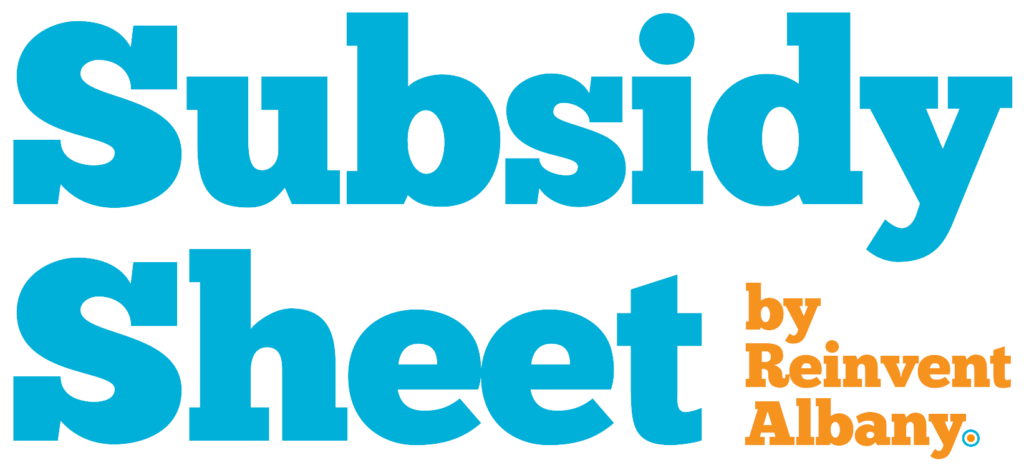Subsidy Sheet: The NY Legislature needs to pass a Database of Deals
Watchdogs Across Political Spectrum Call for Legislation Mandating a Comprehensive Database of Deals
New York spends $4.4 billion on economic development every year – roughly the cost of the new Tappan Zee bridge, or the annual budget for the state of Delaware.
Given how much taxpayer money is spent on corporate welfare, it seems reasonable that New Yorkers should be able to see whether or not this money is creating jobs – through a Database of Deals tracking subsidies. So we welcomed Empire State Development’s (ESD) May 6th publication of a “Database of Economic Incentives.”
Unfortunately, the ESD Database fails to provide basic information about state subsidies to businesses. On May 11th, Reinvent Albany and nine other watchdog groups issued a statement detailing why the legislature must mandate the creation of a much-expanded Database of Deals. The groups say the current database falls far short of minimum expectations for a number of reasons, which we break down in a chart. Of 20 criteria we identified, the Database misses 12, such as:
- The Database only lists very recent projects – those begun in 2018 or later and still active. Projects that began earlier are not included. ESD claims that this is due to the implementation of a “new data management system,” Microsoft Dynamics.
- The Database only includes $852 million in disbursed funds. This is only a small fraction of $4.4 billion – and it’s spread out over three years, which averages out to $284 million a year. That’s only a third of what the state spends every year on the Film and TV tax credit – which itself is not included in the Database.
- There is no way to search how much each business has received in subsidies. Ideally, users would be able to search “Tesla” and view all of the subsidies Tesla is receiving. We cannot. Many subsidies are also passing through other institutions, such as SUNY Research Foundation – and we don’t know which businesses the subsidies go to after.
- Local subsidies are not separated out from private investment. One column lists “total public-private investment” – combining investments from local governments with those from private investors. In other words, taxpayer funds are being counted with investor funds.
- Jobs are included as a whole, rather than differentiated by type. There is no way to view whether jobs created or retained are permanent or temporary, part-time or full-time. In other words, a three-month construction job is recorded the same as a full-time job held for five years.
To ESD’s credit, the database is user-friendly, includes a data dictionary, and is available in the open data portal. But open data is only as good as the data itself.
The New York legislature needs to fill the gaps. There are already two good bills that would accomplish this – Senator Comrie’s S5711 of 2021 and former AM Schimminger’s A2334 of 2019. If the legislature does not act, billions of dollars will continue to be spent in the shadows, and New Yorkers are the ones who will lose.
Other subsidy news
- Great video on $50 million in equipment for Tesla’s Buffalo plant sitting unused in a warehouse. ESD is still searching for a buyer. “It has not lived up to our hopes or our dreams,” Sen. Sean Ryan says of the billion-dollar Tesla deal. “It hasn’t done anything.”
- Amazon is building yet another last-mile warehouse in Nassau County – though no news yet on tax breaks.
- Two Texas think tanks – one left, one right – released a joint statement opposing “unjustified business tax breaks.”
What we’re reading
- “Elon Musk on SNL: Not funny to New York’s taxpayers,” writes Nicholas Waddy in the NY Daily News. The op-ed details the $1 billion in taxpayer funds Tesla received from the state – and the company’s failure to create jobs.
- Fascinating, must-read post from Pat Garofalo at Boondoggle exploring the findings of a new study: When legislative races are competitive, politicians give away more subsidies to big corporations, ultimately making it more difficult for small businesses to compete. The study itself, by Manav Raj, is here.
- Good thread from Citizens Budget Commission on the shortcomings of the NY Regional Economic Development Council model.
- It’s hard to make subsidies accessible, but this video from Houston Chronicle on $10 billion in Texas property tax breaks nails it.
If you got this from a friend, sign up here. Subsidy Sheet is written by Tom Speaker, Policy Analyst at Reinvent Albany. Please send questions and tips to tom@reinventalbany.org. We look forward to hearing from you!

